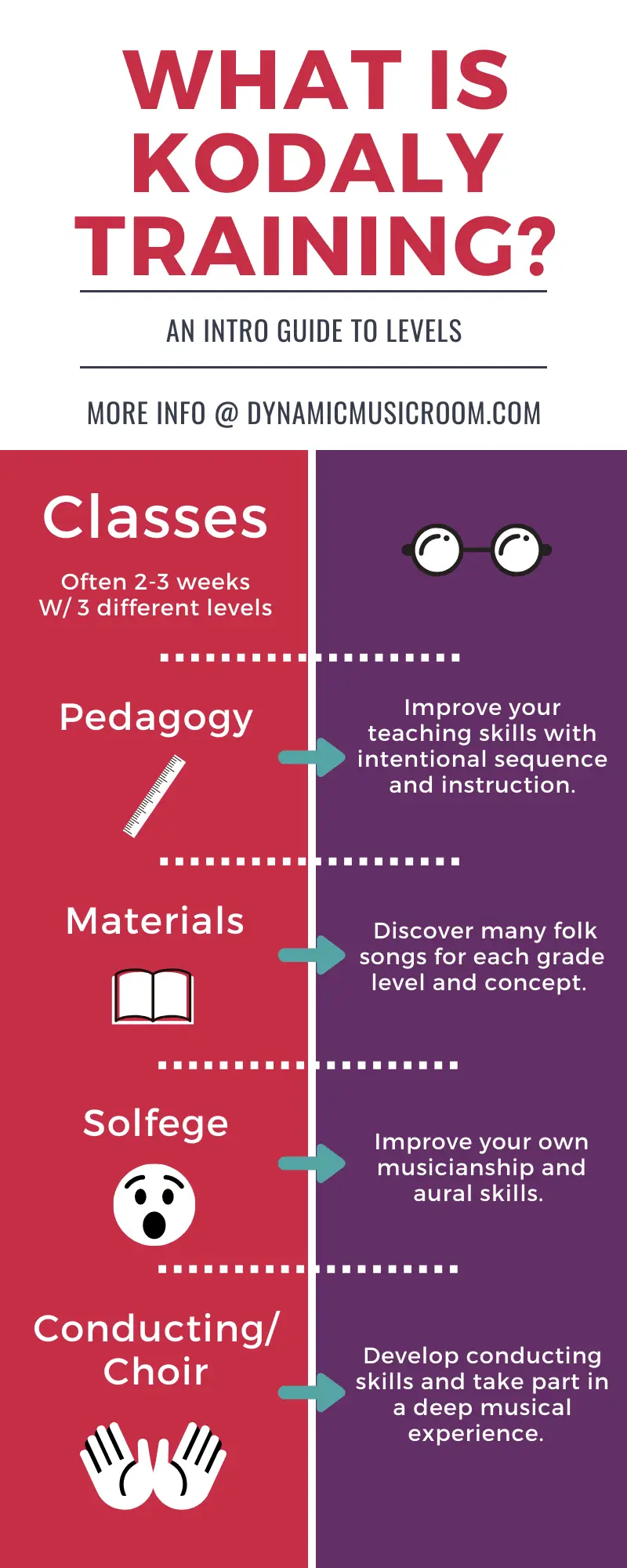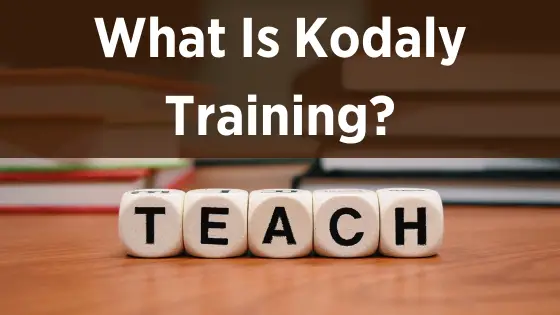Are you interested in getting your Kodaly levels, but you’d like to know what it involves first?
Do you want more information on Kodaly training in general before you commit to the workshops?
I understand your feelings. When I signed up for my first Kodaly level, I didn’t know what to expect and, honestly, picked it just because it was closer to my home.
But boy, did it change everything about how I taught!
So, what is Kodaly training?
Kodaly training is a class usually taken for 2-3 weeks in the summer designed to improve your musicianship as well as your teaching skills. There are often 3 different levels you’d need to take before you become Kodaly Certified. This training is broken up into different sections often including:
- Pedagogy (teaching techniques)
- Materials and analysis of folk songs
- Solfege training
- Conducting
- Choir
- Special Topics (such as children’s choir, multiculturalism, or folk dance)
Read on for more details on what Kodaly training entails.
Disclaimer: I have completed my Level I, II, and III classes to become certified in Kodaly, but I don’t claim to be an expert. I’m drawing the information for this article from my own experience as well as what others who have gone through the program described.
Table of Contents
Classes In Kodaly Training
In this section, I’ll describe the different classes involved in Kodaly training along with the ideas behind them. I’ll also point out some resources some programs use for each class where applicable.
Pedagogy (Teaching Techniques)
To me, this is the heart and soul of a Kodaly levels program.
Pedagogy: the art, science, or profession of teaching.
Merriam-Webster Dictionary
In your pedagogy class, you’ll talk about the tools of the Kodaly “method” including many of the following ideas:
- Sequence of concepts
- Authentic folk material
- Concept planning
- Prepare, present, practice (prove)
- Differentiated instruction
- Establishing procedures
- Learning activities
- Teaching tools such as rhythm, solfege, and hand signs
- Student engagement
- Other best teaching practices
Often, your instructor will talk to you about a specific idea and then demonstrate the tool in a concrete and immediately useful way.
Then, you’ll be asked to prepare for sample lessons in small groups and individually. When you present these, your teacher and colleagues will help coach you and offer suggestions.
How often in your normal school year do you get observed and offered advice by experts in the music field and fellow music teachers? Almost never.
There are many texts you could end up using for pedagogy class. It all depends on the teacher and what they prefer.
One of the more popular resources lately are the Kodaly In The Classroom books by Houlahan and Tacka.
Materials And Analysis Of Folk Songs
One of Zoltan Kodaly’s main reasons for developing his teaching technique (largely inspired by the work of Jeno Adam) was to encourage the students of Hungary to reconnect with the natural music of their culture.
To this end, using authentic folk material is important to providing a good music education. Kodaly was an advocate for using only the best for his students.
In your materials/analysis class, your teacher (which may be the same or different from the pedagogy class) will help guide you to different sources for the songs and how to analyze them.
Analyzing folk songs will be one of the big projects you work on (more in the “Projects” section below), and it is key to developing a good sequence and concept plans which you use in pedagogy.
The analysis you’ll do of folk songs is for your benefit. By looking at the elements that make up the song, you can find the right grade to use the song with.
You can also build your own folk song retrieval systems to find songs by musical concepts really quickly. Currently, I have on 3-ring binder of 175 folk songs analyzed and 1 binder that lists them by concept.
This way, when I want to find a song with syncopation, I just look it up in the one by concept and then find it in the binder with the notation.
(My next goal is to get them all put in on excel/Google Sheets).
A good example of how this would work is at the Holy Names University Folk Song Retrieval system.
As with all of these classes, the books you’ll need depend on the teacher of this class. It seems like many of the teachers share copies of their own retrieval systems.
But, Eleanor Locke’s Sail Way: 155 American Folk Songs to Sing, Read, and Play is a great resource for authentic folk songs.
Solfege Training
Kodaly repeatedly said (as we mentioned before) that only the best was good enough for his students. This applies for the folk material and teaching pedagogy, but it also applies to the teachers’ own musical skills.
Kodaly believed only the best musicians should instruct and guide students on their musical journeys.
Following this idea, all Kodaly trainings include a solfege class. This class involves a teacher challenging and developing your own sight singing skills to a higher and higher level.
Don’t be afraid! Many people are turned off by the idea of this class; it seems scary.
Yes, it is challenging, but the teachers aren’t out there to fail you. They just want to help you improve your own skills.
These 333 Elementary Exercise In Sight Singing by Kodaly is one of the more common ones you may use in your Level I class.
Conducting
Another class you’ll work on is a conducting class. This may seem like something you’re never going to use, but remember, Kodaly wanted well-rounded music teachers.
Also, if you can get your students to conduct themselves (at a basic level) and respond to conducting, you can better reinforce concepts such as meter, ensemble, and steady beat.
Conducting is often intimidating for elementary music folks, but, remember, the teachers aren’t out to get you. They’re just trying to help you build overall musicianship, and conducting is a part of that.
Choir
There’s also a choir class. In this “class”, your goal is just to make good music with your fellow music teachers.
So often, we get caught up in the teaching day by day of our trade that we forget our ultimate goal is to help our students experience good music. Shouldn’t we do that ourselves?
Often, all Kodaly students regardless of level are combined for this class, and at the end of the 2 or 3 weeks, you put on a concert for an audience (not a huge one usually) of friends, family, and other Kodaly alumni.
You don’t have to be a “singer” to enjoy this experience! It’s for everyone!
Please include attribution to Dynamic Music Room with this graphic.
Projects For Kodaly Training
As part of your Kodaly training, you will also need to complete some projects. The goal of many programs is to complete these projects by the time you’re done with three levels of the classes.
So, you may not do all of these in one summer, and the order of the projects may change depending on the specific program, but you can expect to get these done by the time you’re finished with all three levels.
These are based on expectations set out by the Organization of American Kodaly Educators (OAKE) and their endorsed programs. Completing these projects and a certain number of hours of study can earn you Kodaly Certification.
Folk Song Collection And Analysis
By the time you’re done with your levels you’re expected to have a folk song collection of at least 150 songs completely analyzed and put into some kind of retrieval system for you to use.
Usually, this is done over the course of three levels in different years, so you don’t have to do all 150 in one go.
The folk song collection you come up with will need to have enough of a variety of songs that you cover all sequenced concepts and a good sampling of different cultures.
Your materials teacher will guide you in this, so don’t be intimidated.
The goal of this project is to help you leave training with a useful collection of song material and the skills to keep adding to it as you go on with your career.
Folk Song Research
At some point, you’ll be expected to do a research project on a folk song of your choice (with guidance from your teacher).
This research project involves looking at one song and researching the following for a presentation to other members of your training:
- Historical period it was set in
- Earliest mentions, notation, and recording of the song
- Analysis of its applicable concepts
- Comparison of different notable variants of the song
- At least 2 performances of the song (1 live, 1 recorded)
- Application to the classroom
Conduct For The Concert
At some point, you’ll also be expected to conduct something on the end-of-the-course concert. Usually, this is saved for the final level you take.
This one shouldn’t be considered a chore; your conducting will pick a song/piece appropriate to your level, and your choir is made up of music teachers.
They could probably do it without you anyway! No pressure!
Lesson Video And Coaching
Over the course of your time, you’ll also be expected to submit 2 videos of you teaching using Kodaly techniques in your actual classroom.
Then, your teachers will watch the videos and offer you some helpful and real advice. This is designed to rip you apart, but it’s a chance for you to learn from others in your field in a real way.
Usually, the videos are expected to get done during your school year between level I and II and level II and III. But, many programs are flexible if you need a non-traditional solution.
One of the lessons should be focused on a level I concept, and the other would be on a level II concept.
It differs based on exact program, so contact a program’s director to see what they expect exactly.
Where To Take Kodaly Training
Kodaly training and levels are available throughout the USA and the world. OAKE keeps a list of endorsed Kodaly Level programs on their website.
But there are other, smaller programs you can check out as well. These won’t be able to provide with official certification, but they often have fully certified teachers there.
My personal experience was taking my first two levels at one of these smaller programs at Central Michigan University with Dr. Ashley Allen and Dr. Joy Nelson.
After receiving the Jeno Adam scholarship from OAKE, I was able to then transfer and finish the certificate with level III at Indiana University with Nyssa Brown, Dr. Brent Gault, and Dr. Georgia Newlin.
Don’t give up looking for one! Get creative.
Conclusion
I hope we answered your question what Kodaly training is. It’s a series of different classes that prepare you for teaching in an intentional way AND develops your own musical skill and senses.
Are you interested in Kodaly training? What’s holding you back?
Let us know in the comments below.

